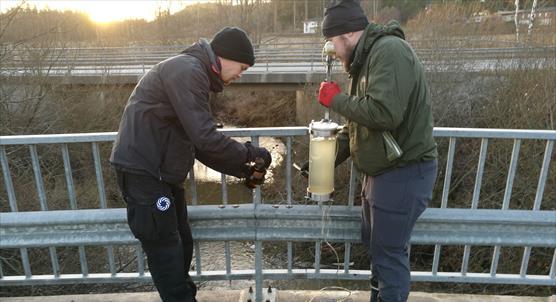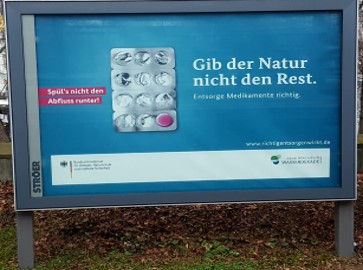Press release 2021-06-21 at 9:00
Hundreds of different medicines are consumed in the Baltic Sea region daily. Medicines benefit human and animal health, but after the use many of them end up to environment and can cause adverse effects to wildlife. CWPharma project worked for over three years to gather and produce data on the consumption of pharmaceuticals and their concentrations in the environment, to identify the most problematic pharmaceutical compounds and to find the best ways to decrease their emissions to the environment.

CWPharma project screened active pharmaceutical ingredients in six river basin districts to get a better picture of their sources, emissions and environmental concentrations in the Baltic Sea region. Twelve out of 75 studied pharmaceuticals were identified as a risk to the environment. © CWPharma Project
The key findings of the project are:
- From human consumption pharmaceuticals spread through wastewater treatment plants to the receiving rivers, lakes and the sea. They can also spread to fields when wastewater sludge is used as a fertilizer.
- Veterinary pharmaceuticals seem to leak from some animal farms to surface waters. Further studies are needed on the use of veterinary medicines and their dispersal in the environment.
- Twelve out of 75 studied pharmaceuticals were identified as a risk to the environment, because their concentrations were higher than what is considered safe. The need to decrease the emissions of pharmaceuticals is thus evident.
The project’s Action Plan for reducing emissions of active pharmaceutical ingredients (API) highlights the need for a combination of emission reduction schemes.
“We can´t reduce these emissions with a single solution. Both improvements in wastewater treatment and waste management and more prudent use of pharmaceuticals are needed to tackle this problem,” states Noora Perkola, a leading researcher in Finnish Environment Institute and the leader of the project “Clear waters from pharmaceuticals” (CWPharma).
According to the Action Plan advanced wastewater treatment technologies, like ozonation and activated carbon, are needed to decrease the emissions of more persistent and ecotoxic compounds such as most of the active pharmaceutical ingredients.
“We think that there should be a clear schedule for advancing the wastewater treatment in the Baltic Sea region and in Europe as a whole. The suggested schedules are based on what would be technically possible, but we did not consider e.g. financial limitations,” Noora Perkola says.

Public awareness campaigning in Germany © CWPharma Project
Action Plan for API emission reduction suggests:
-
Public awareness of the environmental effects of pharmaceuticals must be increased. Both the general public and professionals such as doctors, pharmacists, veterinarians and farmers should be educated on the negative effects that pharmaceuticals have in the environment through national information campaigns. Campaigns should be conducted at least annually during the next five years. Environmental awareness could increase the correct disposal of unused medicines and more prudent use of pharmaceuticals, and thus decrease the emissions. Although it is obvious that illnesses must be treated, some of the environmentally troublesome pharmaceuticals can be replaced with pharmacologically similar but environmentally less problematic ones, and unnecessary medication can and should be avoided.
-
Management of pharmaceutical waste should be improved. All Baltic Sea region countries should have a take-back system for all unused human and veterinary medicines from households. Places where pharmaceutical waste is generated in larger amounts – such as large livestock farms, hospitals, medical clinics, elderly care homes and other healthcare institutions – should be obliged by law to collect their pharmaceutical waste and send it directly to waste treatment facilities.
-
One of the most effective ways to decrease the pharmaceutical emissions is enhancing wastewater treatment. As the first step all wastewater treatment plants in all BSR countries should comply with both the current Urban Waste Water Treatment Directive (before 2022) and the revised directive when it is published. Conventional wastewater treatment can remove some pharmaceuticals, but many others are not removed sufficiently to avoid risks to the environment. Advanced wastewater treatment (AWT) technologies, like ozonation and activated carbon, are needed to decrease the emissions of more persistent and ecotoxic compounds. Wastewater treatment plants (WWTPs) with a population equivalent (PE) above 250,000 should be equipped with the appropriate advanced technology for removing APIs and other environmentally hazardous compounds latest by the year 2030 and smaller WWTPs (> 50,000 PE) by the year 2040.
- Manufacturing of pharmaceuticals can be a major point source of pharmaceuticals to the environment. Pharmaceutical plants should be required to obtain environmental permits that mandate the plants to estimate their API emissions and impacts on WWTPs and surface waters. When necessary, environmental permit requirements for pharmaceutical plants should be further supplemented with industrial wastewater contract requirements.
-
Environmental concentrations of the pharmaceuticals that pose risks to the environment should be monitored. They should be included in regular environmental monitoring programmes managed by national or regional authorities to improve knowledge and management of risks.
-
To improve risk assessment and management, further research is still needed. Future project funding should focus on a) further development of analytical methods, especially for metabolites, hormones and antibiotics, prioritising those seldom analysed so far; b) more comprehensive screening and monitoring campaigns to produce a representative overview of API concentrations in the environment; and c) producing more ecotoxicological data on single APIs and their metabolites, on mixture toxicity, on toxic effects for different trophic levels, and on chronic effects.
An extension stage project CWPharma 2 continues the work on upgrading wastewater treatment plants. This work utilizes the guideline for optimising advanced wastewater treatment produced in CWPharma project.
Contacts:
-
CWPharma main project: Project Leader, Leading Researcher Noora Perkola, Finnish Environment Institute, tel. +358 295 251 507, e-mail: noora.perkola@syke.fi.
-
CWPharma 2 extension stage: Project Leader, Professor Kai Bester, Aarhus university, tel. +45 935 080 89, email: kb@envs.au.dk
- Communications Specialist Eija Järvinen, Finnish Environment Institute, tel. + 358 295 251 242, e-mail: eija.jarvinen@syke.fi
More information:
CWPharma in a nutshell
- The project ran from October 2017 to December 2020.
- The consortium consisted of 15 organisations, from seven countries in the Baltic region: Denmark, Estonia, Finland, Germany, Latvia, Poland, and Sweden. Its work is co-ordinated by the Finnish Environment Institute (SYKE).
- CWPharma was financed by the EU’s Interreg Baltic Sea Region Programme for 2014–2020. The project was supported by the EU Strategy for the Baltic Sea Region under the ‘Hazards’ policy area as an integral part of the flagship Pharmaceuticals in the Environment (PIE) effort, a Baltic Sea regional co-operation platform.
|